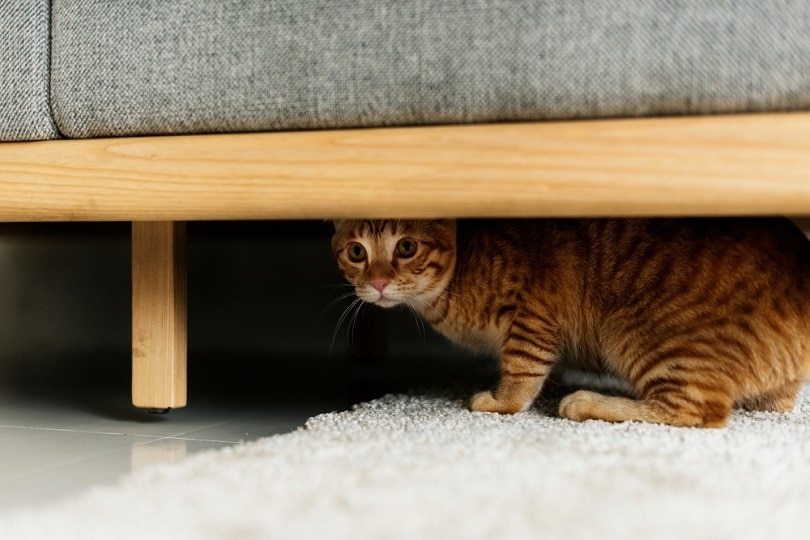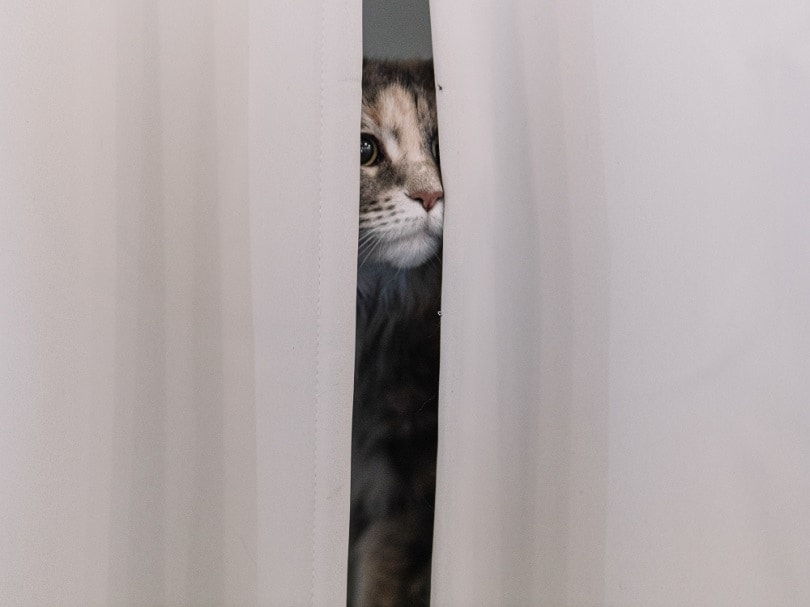My Cat Is Hiding After a Move to a New Home, What Do I Do? (Vet-Approved)
Updated on

It doesn’t matter whether you’re moving next door, across town, or to another country; cats don’t like change.
You can find stories online about cats getting lost during moves, running away to find their way back to their old home, or hiding for weeks when you’re trying to settle into your new place.
That’s why handling the move with your cat is critical in every stage, from packing your things to moving and settling in after the ordeal is complete.
So, how do you handle moving when your cat escapes to its hiding place? We’ll answer that question and more in the post below.
Before the Move
Before we can get into what to do about your cat hiding after you move to a new home, we need to give you a few tips on preparing your cat for the move.
The best thing to do before you even pack the first box is to create a safe room for your feline friend to be in while you’re packing. However, you can take out a few boxes to prepare your cat for seeing them around the home.
As a pet parent, you know that cats like their routines, and anything that disrupts the daily schedule can drive them crazy. Therefore, the safe room you create should include the following items.
- Litter box
- Favorite toys
- Food and water bowls
- Comfy bed
- Scratching post
- Carrier
Once the safe room is set up, let your pet stay in the room during the packing and moving process since it might upset the cat. Besides that, the door is often open during the moving process, and you don’t want your cat to run outside.
The 5 Things to Do When Your Cat Hides

First, it’s essential to realize that hiding is a normal reaction for a cat when moving to a new place. Cats hide when they are introduced to a new environment or situation, and you shouldn’t be worried about that aspect.
1. Act Normal/Don’t Panic
If you’re stressed and panicky, your pet will pick up on your emotions and act the same way. But, since the cat doesn’t understand why you’re stressed, it’ll react by going into hiding to cope.
The best thing you can do is take a deep breath, calm your stress levels, and create a peaceful environment for your feline and yourself. The fact that you’re worried about your cat hiding could possibly be the reason it’s hiding.
2. Go About Your Normal Routine
As you probably know, cats watch their owners carefully, and it’s possible that your cat is watching what you do in your new home. If you don’t follow your regular routine, it could make the cat nervous.
Following the same routine as you did in your previous home will show your cat that nothing has changed. In addition, this will make your new house feel safe, just as your old home did.
3. Give Your Cat Extra Attention and Love

It’s possible that your cat was overlooked and neglected during your move. While you didn’t mean to ignore your pet, moving is stressful and time-consuming.
Take a break to give your cat a little extra love and attention in the days following the move, and they’ll bounce back in no time.
4. Set Up a Quiet Room for Your Cat
The whole house might be too big of an area for your cat to feel comfortable in, especially if you’re moving to a larger home from an apartment.
Set up a small room as the safe room, like you did before you made the move, for the best results. Don’t close your cat into the room but have it available whenever it wants to be secluded and away from the rest of the house until it gets used to the new environment.
5. Coax Your Cat to Explore on its Own
Even though you don’t want to force your cat to come out of hiding, you can coax and encourage it to explore the surroundings. For example, you can put out treats and toys you know your cat loves to try and lure it into exploring the new home.
When Should You Worry?
As previously stated, a cat hiding when put into a new environment is normal behavior. However, they should shortly become accustomed to the new house and be fine.
If your cat is looking unkempt, not cleaning itself, and has a reduced appetite, it might be a cause for concern. If this occurs for more than a couple of days, it’s time to contact your vet.
Final Thoughts
Cats hiding when you move them to a new home is normal, and it’s best to give the cat its space and let it come out and explore in its own time. Some cats may take a couple of weeks to get used to the new environment. However, if you notice drastic changes in your cat’s behavior that last more than a few days, it’s best to contact your vet for an appointment.
See also:
- Cat Emotions: Do They Have Feelings? What the Science Says
- Why Does My Cat Hide? 3 Likely Reasons (Vet Answer)
Featured Image Credit: Rawpixel.com, Shutterstock











